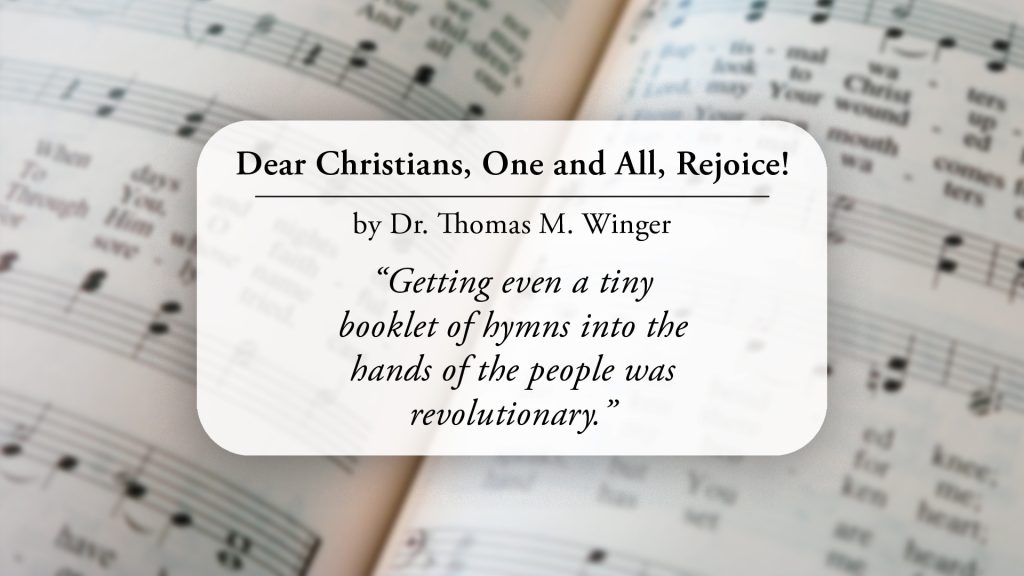Dear Christians, One and All, Rejoice!
Celebrating the Birth of Lutheran Hymnals

by Thomas M. Winger
The genius of Lutheranism is our clear teaching of justification by grace through faith in Christ alone. But the joy of Lutheranism is our hymns! This year, as part of the 500th anniversary of the Reformation celebrations, we remember the first Lutheran hymnals, published in 1524.
Hymn-singing has been part of God’s worship since the Old Testament. The book of Psalms is a hymnal within the Bible. The Psalms were used in Temple and Synagogue services, and naturally remained part of early Christian worship. St. Paul called for Christians to “be filled up in the Spirit, speaking to each other in psalms and hymns and songs of the Spirit” (Ephesians 5:18-19). These “hymns and songs” may have included biblical canticles, such as we find in Luke 1-2 and sing in Matins and Vespers. But it’s likely that the early Christians also expressed their faith in hymns of their own making.
Hymnody flourished for centuries, particularly in monasteries; but, sadly, there was little congregational hymn-singing in the chief Sunday service by the high Middle Ages. German hymns existed but were usually sung in processions and festivals rather than in church. Early Lutherans saw an opportunity to spread the Gospel by reviving congregational song. Luther seems to have got the idea from the popular practice of news ballads. Singers would put the news into rhyme and sing it to the people in town squares and inns, then print up the song on a broadsheet to post. In 1523, Luther imitated them by writing a sober tribute to two followers who had been martyred in Brussels. His ballad, “A New Song We Now Begin”, wasn’t really a hymn, but it sparked the brilliant idea of spreading the good news of the Gospel through song. In the preface to an early hymnal, he wrote: “I… have with the help of others compiled several hymns, so that the holy Gospel which now by the grace of God has risen anew may be set forth and given free course” (LW 53:316).
His ballad, “A New Song We Now Begin”, wasn’t really a hymn, but it sparked the brilliant idea of spreading the good news of the Gospel through song.
In the years 1523-26, Luther threw all his energy into reforming worship. In his revision of the Latin mass (1523), he called for vernacular songs for the people to sing between the Epistle and Gospel (the Hymn of the Day) and during Communion distribution. He encouraged poets and musicians to find a unique German way to match words to music. Luther accepted his own challenge and wrote 24 of his lifetime output of 36 hymns in just one year! In his German Mass (1526), he added the idea of singing the major texts of the liturgy in hymn paraphrases; see, for example, his creed hymn, “We All Believe in One True God” (LSB 954). But we’re getting ahead of the story.
In January 1524, an enterprising printer gathered together eight hymns that had been recently printed on broadsheets and published the first Lutheran hymnal. Known popularly as the Achtliederbuch (“Eight Hymn Book”), it contained four hymns by Luther, three by his colleague Paul Speratus, and one anonymous. Remarkably, three of these hymns are still in use:
• “Dear Christians, One and All, Rejoice” (LSB 556), by Luther
• “Salvation Unto Us Has Come” (LSB 555), by Speratus
• “From Depths of Woe I Cry to Thee” (LSB 607), by Luther
The first two tell the epic tale of our salvation, from the tragedy and helplessness of our sinful condition to God’s sending forth His Son in the flesh to redeem us. They teach the distinction between Law and Gospel, and are spectacular illustrations of how the reformers sang the pure Gospel into people’s hearts. The little hymnal included music for both hymns—the same joyful and sturdy tunes to which we sing them today. Luther probably wrote the music for his hymn. The tune for the second hymn is mediaeval. The third hymn is Luther’s paraphrase of Psalm 130. Putting the Psalms into rhyming verse was a Lutheran innovation that would later be copied by Calvinists and which also lies at the heart of Anglican hymnody. What was unique about the Lutheran approach was how they wove the Psalm’s deeper Christological meaning into the paraphrase. The hymnal provided two other Psalm paraphrases by Luther and set all three to the familiar tune of “Salvation Unto Us Has Come,” making it easy for the congregation to learn and use them.
Getting even a tiny booklet of hymns into the hands of the people was revolutionary. But the larger collections published later that year more deservedly bear the title of “hymnal.” The Erfurt Enchiridion included the eight hymns in the Achtliederbuch, and added 14 more by Luther and two by his colleagues—including by the talented pastor’s wife, Elisabeth Cruciger (“The Only Son from Heaven”, LSB 402). Among the new Luther hymns were the Advent favourite, “Saviour of the Nations, Come” (LSB, 332); the Easter masterpiece, “Christ Jesus Lay in Death’s Strong Bands” (LSB 458); the Communion hymn, “O Lord, We Praise Thee” (LSB 617); and a translation of the mediaeval Pentecost hymn, “Come, Holy Ghost, God and Lord” (LSB 497). These examples illustrate the Lutheran desire to integrate hymn singing into the liturgy—hymns weren’t just entertainment or diversions but served the overall message of the divine service that day. From then on, all Lutheran hymnals would be organised according to the church year.
Getting even a tiny booklet of hymns into the hands of the people was revolutionary.
Luther’s call for poets to produce new hymns sparked a veritable explosion (though he did most of the work himself!). Another hymnal probably published later in 1524 in Wittenberg included a remarkable 32 hymns (18 of them are found in LSB). But what appeared with it was even more remarkable. Luther’s musical adviser, the court composer Johann Walter, produced a companion choir book (Chorgesangbuch) containing four- and five-part choral settings so the choir could teach the new hymns to the people. This new role for the choir—to guide and gild the congregation’s song—would be the hallmark of Lutheran worship up to its pinnacle in the cantatas of J. S. Bach, almost all of which were based on these great early Lutheran hymns.
In addition to writing texts from scratch, Luther and his colleagues drew on a rich tradition of mediaeval hymns: thousands of Latin hymns sung by monks in the daily offices, festive processional hymns, choir songs in the liturgy (e.g., LSB 459/460), and popular carols from the town square. Luther was a talented musician and surrounded himself with professionals. Together they developed a pattern of music suited to the German text by simplifying Gregorian chant tunes and borrowing just a bit from folk music and the art song of the master singers. Their music was rhythmic, robust, attractive, and singable by average people. But they most certainly did not borrow drinking songs—that’s an old myth that deserves to die!
The titles of many early Lutheran hymnals emphasised the twin themes of “teaching” and “comfort” in their contents. Hymns were part of the overall programme of reforming the church through God’s Word. As hymns distilled biblical teaching, early hymnals also included lists of important Bible passages and served as a digest for people who perhaps couldn’t afford or even read the full Bible. Lutheran hymns could be strongly doctrinal (teaching). Luther systematically wrote a hymn for each chief part of the Catechism. But the reformers also drew the congregation into the liturgy by letting them sing parts that previously were sung only by choirs made up of clergy (or schoolboys). Hymns served the liturgy by highlighting and expounding the season of the church year. Countless Psalm paraphrases gave voice to Christian piety and faith by bringing the ancient texts into contemporary Christian lives; ”A Mighty Fortress” (LSB 656), which turned Psalm 46 into a battle cry against their devilish foes, is the most famous example.
 Perhaps hymns were part of the Reformation’s genius, too!
Perhaps hymns were part of the Reformation’s genius, too!
———————
Rev. Dr. Thomas M. Winger is President of Concordia Lutheran Theological Seminary in St. Catharines, Ontario.





